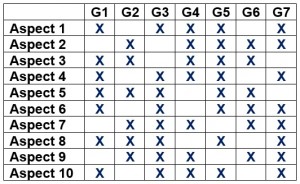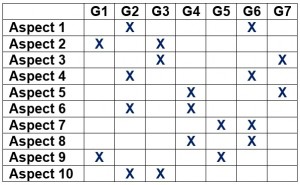Did Jesus Exist? Ehrman’s Complete Failure – Part 1
I was recently asked to participate in a public discussion/debate about the question “Did Jesus Exist?”. I don’t plan to argue in favor of the mythicist position, just because I don’t think I would do it justice. I’m not a mythicist, and I have not studied any mythicists in recent years (I read some of G.A. Wells books years ago, and I read Earl Doherty’s The Jesus Puzzle some years ago). But I do have significant doubts about the existence of Jesus, and especially about the strength of the historical case for the existence of Jesus.
In order to prepare for the discussion, I pulled out my copy of Bart Ehrman’s book Did Jesus Exist? (hereafter: DJE) and began to re-read his positive case for the existence of Jesus. I have criticized part of his case previously, so I began reading with the assumption that his case was weak and problematic, at least the initial argument that he makes based on seven allegedly independent Gospels, in Chapter 3. Upon re-reading this Chapter, my conclusion is that this important part of his case is not just weak, it is a complete and utter failure.
I’m reminded of William Lane Craig’s argument for the claim that “Jesus died on the cross” in his book The Son Rises. I went through Craig’s argument, line by line, and showed that while he made dozens of historical claims, there was not one single historical fact in the entire passage (there was one reference to one passage from one historical document, but upon examination of the document, the passage, its authorship, and its content, there was no real evidence for the specific historical claim being asserted).
I realize that Ehrman is not a Christian believer, and so obviously he is not a Christian apologist. But there is a clear parallel between Chapter 3 of Did Jesus Exist? and WLC’s argument for the claim “Jesus died on the cross” in his book The Son Rises. In both instances, we are set up with the expectation and promise that a strong historical case will be made for a basic Christian belief, but the case includes arguments that are virtually FACT FREE. I suspect that Ehrman’s thinking was corrupted by exposure to Christian apologetics, and this has, sadly, led him to construct arguments for historical claims without bothering to mess with those inconvenient little things known as historical facts. Jesus Freaking-H-Christ! (… an historically relevant curse for this occasion).
I respect both WLC and Ehrman. They are both intelligent men and knowledgable about their fields. They are both hard-working scholars. I have learned much from both Craig and Ehrman. I don’t claim to be smarter than they are, or to have more knowledge than they have, nor do I claim to work harder than they do. They are scholars and I am not a scholar.
Nevertheless, I could do a better job defending these basic Christian beliefs with one hand tied behind my back while blindfolded. I am very confident that I could do a better job, because I would make use of actual historical facts to make my case. I may not be a brilliant scholar, but I know better than to make a fact-free case for an historical claim. WLC and Ehrman evidently missed that memo.
Here is how Ehrman characterizes himself and his view on the question of the existence of Jesus:
But as a historian I think evidence matters. And the past matters. And for anyone to whom both evidence and the past matter, a dispassionate consideration of the case makes it quite plain: Jesus did exist. (DJE, p.6, emphasis added)
Apparently evididence matters to Ehrman, except when he is laying out a key argument in his case for the existence of Jesus, because he doesn’t bother to provide ANY historical evidence for his key historical premise, though many dozens of pieces of historical evidence would be required to properly support that premise.
Here is how Ehrman characterizes his main goal in the book:
My goal, however, is neither to please nor to offend. It is to pursue a historical question with all the rigor that it deserves and requires and in doing so to show that there really was a historical Jesus and that we can say certain things about him. (DJE, p.37, emphasis added)
Making an argument for an historical claim without presenting any historical evidence in support of the key historical premise of a key argument means that Ehrman not only fell short of fully realizing this goal, it means that Ehrman completely and utterly failed to even partially acheive this goal, at least in terms of the argument about corroboration between seven Gospels that he presents in Chapter 3 (he does manage to do a somewhat better job with the argument presented in Chapter 4).
Ehrman’s positive case for the existence of Jesus is given in Part I, which encompasses Chapters 1 through 5. But Chapter 1 just introduces the mythicist viewpoint, and Chapter 2 basically dismisses all of the non-Christian writers/sources. So, the positive case for the existence of Jesus is given in just three chapters: Chapter 3, Chapter 4, and Chapter 5. The title of Chapter 3 indicates the content of the argument in that chapter: “The Gospels as Historical Sources”. Craig miserably failed to prove that “Jesus died on the cross” largely because he made the absurd assumption that he could do this in just a few short pages. Ehrman makes bascially the same mistake in Chapter 3 of DJE.
The basic principle used in this key argument was spelled out in Chapter 2, but is nicely summarized in Chapter 3:
…historians, who try to establish that a past event happened or that a past person lived, look for multiple sources that corroborate one another’s stories without having collaborated. And this is what we get with the Gospels and their witness of Jesus. (DJE, p.75)
There is more than one argument presented in Chapter 3, but a key argument is summarized by Ehrman at the end of Chapter 3:
We are not dealing with just one Gospel that reports what Jesus said and did from sometime near the end of the first century. We have a number of surviving Gospels–I named seven–that are either completely independent of one another or independent in a large number of their traditions. These all attest to the existence of Jesus. Moreover, these independent witnesses corroborate many of the same basic sets of data–for example, that Jesus not only lived but that he was a Jewish teacher who was crucified by the Romans at the instigation of Jewish authorities in Jerusalem. (DJE, p.92, emphasis added)
One could summarize the key premise of this argument in one sentence (about: Agreements Between Seven Independent Gospels):
(ABSIG) There are seven Gospels which were written within “a hundred years after the traditional date of Jesus’s death” (DJE, p.78) that are “either completely or partially independent” from each other (DJE, p.78) and yet they “agree on many of the basic aspects of Jesus’s life and death” (DJE, p.86).
The agreement on “the basic aspects of Jesus’s life and death” is asserted by Ehrman about the written sources that were allegedly used in the composition of the seven Gospels. But we know of the content of the alleged written sources of these seven Gospels only by carefully studying the content of the seven surviving Gospels; we don’t have manuscripts of the alleged written sources (with the exception of the Gospel of Mark, which was one of the sources used in the composition of Matthew and in the composition of Luke). We only have manuscripts of the seven surviving Gospels. So, any alleged agreements between the written sources behind the seven Gospels must be discernable in the existing texts of the surviving Gospels.
In the above quotations, there is a subtle clue that indicates Ehrman has failed to do his homework on this argument. The word “many” in the phrase “agree on many of the basic aspects of Jesus’s life and death” points to a fundamental flaw of Chapter 3. The word “many” is vague. If Ehrman had actually investigated the evidence on this issue “with all the rigor that it deserves and requires”, then he would have provided a specific number here, instead of the vague quantifier “many”. But he did not do his homework, and so he was unable to provide a precise quantity.
Agreement on three or four characteristics of Jesus or events in Jesus’s life might qualify as “many” agreements, but that would not be very impressive as an argument for the existence of Jesus. Presumably, a strong case would involve something on the order of one or two dozen agreements on “basic aspects of Jesus’s life”. But let’s just consider a conservative and round number of agreements that could potentially constitute a strong case: TEN.
Since we are talking about seven “independent” Gospels, a perfect argument for ten basic aspects would involve about 70 pieces of historical evidence, in which each of the seven Gospels has at least one passage that confirms each of the ten “basic aspects of Jesus’s life”. But some of the “Gospels” are not very extensive, so those Gospels would probably only confirm a few of the ten basic aspects. Even the more extensive Gospels might not confirm all ten basic aspects of the life of Jesus, and yet the overall argument could still be fairly strong.
It seems to me that a fairly strong argument could potentially be made if an average of five out of seven Gospels confirmed each of the ten basic aspects. Then we could justifiably say that “Each of the ten basic aspects of the life of Jesus is confirmed by most of the seven Gospels”.
A matrix diagram is the obvious way to present an overview of the relevant historical data. An ideal matrix, one that represents what is potentially a fairly strong case, would look something like this, where an “X” means that there is at least one passsage in that Gospel that confirms the basic aspect of Jesus’s life (click on the image below for a better view of the matrix diagram):
In order to support this ten-aspect matrix, one would need to provide about 50 separate pieces of historical data, i.e. fifty different specific passages from the various seven gospels. In some cases, a single passage from one gospel will support two or three basic aspects, reducing the required number of pieces of data. But in some cases, one gospel will have two or three passages confirming just one aspect, increasing the number of pieces of data supporting the diagram. So although this diagram does not require exactly 50 pieces of historical data, the number of pieces of historical data supporting this diagram would probably be close to 50.
If only two or three out of the seven Gospels support a given basic aspect, on average, then the argument for the existence of Jesus would be pretty weak, and the matrix diagram would look something like this:
Note that even to make this very weak argument for the existence of Jesus, one would need to provide about 20 to 30 pieces of historical data (quotations from about 20 to 30 passages from the seven “independent” gospels).
Does Ehrman’s matrix look like the first one, with lots of X’s and very few blanks? Or does his matrix look more like the second one, with only a few X’s here and there and lots of blanks? Neither. Ehrman has no matrix diagram at all.
OK, that is not a deal breaker. We can fill out a matrix diagram for Ehman, based on the historical evidence that he provided in Chapter 3. How many pieces of historical data does Ehrman provide that we could use as the basis for constructing such a matrix? Does he provide 50 passages from the seven Gospels? No. Forty passages from the seven Gospels? No. Thirty passages? No. A measly twenty passages? Nope. Ehrman provides exactly ZERO passages from the seven “independent” Gospels to support his key premise (ABSIG).
So, here is the appropriate matrix diagram representing Ehrman’s argument from the agreement between seven “independent” Gospels (ABSIG):
I am not impressed, and I am certainly not convinced.
Ehrman does sometimes quote a Gospel passage in Chapter 3, but not for the purpose of showing how that Gospel supports a specific “basic aspect” of the life of Jesus. In Chapter 3, Ehrman quotes Luke 1:1-3 on pages 73 and 79, but not to show that this Gospel confirms a specific basic aspect of the life of Jesus that othere Gospels also confirm. The quotation of Luke on page 79, for example, is to support the general claim that “the Gospels…were based on earlier written sources…” (DJE, p.78).
Ehrman quotes three passages from the Gospel of Mark and one passage from the Gospel of John on pages 87-89, but the point of that evidence was to show that these Gospels include written sources that ultimately were “based on oral traditions” (DJE, p.86) that were “originally spoken in Aramaic, the language of Palestine.” (DJE, p.87). The purpose of these quotes is to support the claim that the Gospels can be traced back to early oral traditions, traditions that existed shortly after the standard date for the crucifixion of Jesus.
On page 90 of DJE, Ehrman quotes a passage from the third chapter of the Gospel of John, but the purpose of that quote is just to illustrate how Aramaic can be used to determine that some Gospel passages (like the one quoted from John) are NOT based on early oral traditions about Jesus (which were in Aramaic).
There are no other quotations from the four canonical Gospels in Chapter 3 of DJE. There are also no quotations in Chapter 3 from the Gospel of Thomas, or from the Gospel of Peter, nor are there quotations from “the highly fragmentary text” called Papyrus Egerton 2. Therefore, there are ZERO quotations (from any of the seven “independent” Gospels) that are given in support of the key historical premise (ABSIG) of a key argument in Ehrman’s positve case for the existence of Jesus.
If Ehrman had provided twenty to thirty different passages, some from each of the seven “independent” Gospels, showing that two or three of the Gospels support each of ten “basic characteristics” of the life of Jesus, then I would conclude that he had presented an argument which was potentially, at best, a very weak argument for the existence of Jesus. But Ehrman has in fact provided ZERO relevant quotations from the seven “independent” Gospels, so this argument is a complete and utter failure. It should persuade nobody, because there is no historical evidence provided to back up the main historical premise of this argument.
In Chapter 3 of DJE, Ehrman has presented a FACT FREE argument for the existence of Jesus, which is completely contrary to his claim that he thinks “evidence matters” and completely contrary to his goal to pursue the historical question of whether Jesus exists “with all the rigor that it deserves and requires”. Ehrman promised devotion to evidence and he promised scholarly rigor, but what he delivered is pure BULLSHIT, at least with his argument concerning Agreements Between Seven Indendent Gospels (ABSIG).
There are other serious defeciencies with this argument in Chapter 3, but I will save discussion of those for another post.






